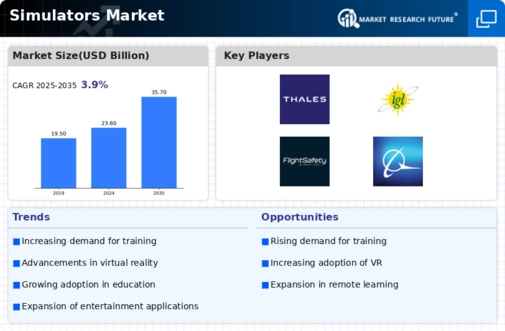Market Analysis
In-depth Analysis of Simulators Market Industry Landscape
Dynamics in the simulator industry reflect the changing environment of training and simulation technology across sectors. The growing need for affordable and realistic training options drives market dynamics. Simulators allow companies to improve employee abilities without the cost of actual training. Aviation, military, healthcare, and manufacturing understand the benefits of simulation technologies in delivering hands-on experience in a regulated and safe environment, driving the Simulators Market.
Technological advances shape the Simulators Market. Hardware and software advancements make simulators more realistic and complex. High-fidelity visuals, immersive VR experiences, and powerful physics engines make simulations more realistic and genuine for trainees. The market innovates and incorporates cutting-edge technologies into simulator systems to meet demand, creating a competitive environment where technology is crucial.
Defense Simulators Market dynamics are driven by global security and military readiness. sims help military personnel prepare for difficult situations like flying sims and warfare operations. Defense forces globally invest in updating their training methods, increasing demand for sophisticated simulation equipment. Defense spending, geopolitics, and the need to adapt to changing security threats affect market dynamics.
Aviation Simulators Market dynamics are driven by regulatory requirements and pilot training demand. Pilots must undergo simulator training from the FAA and EASA to assure competency and safety. To meet these needs, the industry offers flight simulators that recreate real-world flying circumstances for pilot training and certification. Global air travel demand drives pilot training, expanding the aviation simulators industry.
Simulation market dynamics are driven by healthcare simulation. Doctors use simulations to improve their diagnosis and treatment abilities. Healthcare professionals may practice and improve their skills in risk-free simulated operations, patient situations, and medical crises. The healthcare simulators market sector grows as medical education and training use simulation technology to improve patient outcomes and healthcare professional competency.
The COVID-19 epidemic has increased virtual and remote training use, affecting the Simulators Market. To ensure training continuity, businesses used virtual simulators and online training platforms due to travel constraints and social separation. This move towards remote training solutions has raised demand for simulators that can be accessed and controlled remotely, stressing market flexibility and adaptability.
The spread of simulation applications outside conventional areas affects market dynamics. Automotive, energy, and entertainment industries are increasingly using simulation technology for training, development, and research. Simulators are used in many sectors because they can simulate many situations and settings, growing the market and influencing simulation technology development.
The Simulators Market is driven by the demand for cost-effective training solutions, technological advancements, military preparedness, aviation regulations, healthcare simulation needs, global events like the COVID-19 pandemic, and the growing use of simulation technologies across industries. As simulation systems become more complex and diverse, they improve training, skills development, and preparation across sectors, altering the Simulators Market to meet current industry demands.








Leave a Comment